
Yas Rana examines where Jason Roy stands after a difficult summer for England.
The numbers make grim reading. Across England’s six T20Is this summer, Jason Roy faced 98 balls and scored just 76 runs – an average of 12.66 with a strike-rate of 77.55. At times it was torturous viewing as the normally destructive opener registered scores of 4 (16), 0 (1), 27 (26), 8 (15), 20 (22) and 17 (18) in a high-scoring summer of T20I cricket.
It used to be said of Roy in T20 cricket that even if he fails there’s little loss for the team given his rate of scoring – his failures generally don’t waste many balls. But now they are. Left-arm spin has long been Roy’s nemesis in white-ball cricket and it was a match-up that South Africa utilised well throughout their white-ball tour. Twice South Africa opened up with Keshav Maharaj in the T20Is and on both occasions Roy struck at less than a run a ball against the Proteas tweaker, not scoring a boundary off him in either game. But while that has long been a feature of Roy’s game – and one that he has arguably put right in recent times before this summer – the variety of his struggles stood out. Against the pace mix-ups of Lungi Ngidi and the speed of Kagiso Rabada and Anrich Nortje, Roy was well away from his best.
There may be some mitigating factors at play. England have slightly less batting depth in their XI at the moment compared to how they lined up in last year’s T20 World Cup. Eoin Morgan has effectively been replaced by Sam Curran in the top seven and with Richard Gleeson and Reece Topley in the XI for the opening two games against South Africa, England’s tail was noticeably weaker than it was last year. In the IPL, we regularly see potentially destructive operators reigned in by shallower batting line-ups below them – it might be a small factor in Roy’s change in output here. As might the absence of Morgan as captain. A mark of Morgan’s England was how underperforming batters still maintained the confidence to bat aggressively; that is an environment that shouldn’t be taken for granted, nor one that should be assumed to be easily replicated.
Despite his recent struggles, some of the calls for Roy’s head have been premature – especially those that have argued for his discarding in ODI cricket as well as T20Is. For starters, he has always been a different beast in the two major white-ball formats. His ODI record – with an average over 40 coupled up with a strike-rate over 100 – is right up there with the very best to open the batting in the format; his return from injury during the 2019 World Cup was arguably the turning point in England’s 2019 World Cup campaign. In T20 cricket, his fast starts have been emblematic of how England play white-ball cricket but in a crowded field Roy has never really been an elite T20 opener in the league of Jos Buttler, Jonny Bairstow, David Warner, or KL Rahul. Even at his best, he has never forged a permanent spot as an opener in an IPL team; since first going to the tournament in 2017, he has still only played 13 games in the competition.
His ODI spot shouldn’t be under question, especially considering the dual retirements of Morgan and Ben Stokes. But in T20Is, where he has less pedigree, there is a case to be made that he is no longer in England’s best XI. Phil Salt is the batter closest to Roy’s mould but his decent T20 career record is skewed by particularly impressive Blast stats (widely regarded as one of the weakest of the major leagues) and has really struggled in the Pakistan Super League – arguably the best league outside the IPL – while his Hundred numbers last summer underwhelmed. Will Smeed enjoyed an impressive maiden PSL and remains a tantalising option, while James Vince has racked up runs and trophies relentlessly in the past 12 months, but the most serious threat hanging over Roy’s place in the side is the return of Stokes, who remains available for the T20 World Cup despite his recent lack of T20I appearances.
It is a hard batting line-up to break into. Buttler and Bairstow are nailed on starters while Malan’s T20I record is imperious. Moeen Ali, Sam Curran and Liam Livingstone all offer something with the ball and have particular strengths batting in the lower middle order. Though Stokes is an additional bowling option himself, he isn’t the fastest starter and is more suited to a position up the order. Albeit from a limited sample size of 14 games, his record opening in T20 cricket is excellent – an average of nearly 40 with a strike rate of 140 – and it’s the position from which he scored a scintillating IPL hundred against a world-class Mumbai Indians attack two years ago.
If Roy is discarded, it doesn’t have to be terminal for his T20I career. He was dropped from the ODI side after a similarly barren run during the 2017 Champions Trophy before returning to the XI in time to be a World Cup hero two years later. A stellar Hundred campaign would dispel immediate doubts about his place in the side, but given the nature of his failures against South Africa and India – where he didn’t just register low scores, he took up too many balls in doing so – he can have few complaints if he is the player to make way for the retuning Stokes before the T20 World Cup.








